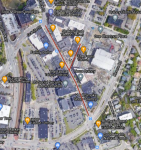Let's say this hypothetical renovation/reconstruction project has a price tag of, what, $5 million or so? What if every single penny of that (you'd actually need a lot more, but $5 million seems like a good start) was instead diverted to coming up with a permanent--
but progressive and humane--solution to the Carl Barron Plaza's chronic issues with homeless/addicted/mentally disturbed folks. So then you have a public space that is suddenly desirable to be programmed by all sorts of civic groups, as folks are no longer in fear of witnessing [or being accosted by] unpleasant things. Thus, all sorts of street fairs, concerts, etc., start to get programmed there, basically year-round. How does this conversation look then?
I'm not saying the renovation/reconstruction initiative isn't a worthy goal. Of course it is. But does it really take priority over coming up with an enduring toolbox of socioeconomic interventions to permanently alleviate the CBP's chronic homelessness issues? Especially because--say this renovation/reconstruction happens, there's a ribbon-cutting, etc.
The very next day, the same homeless crowd returns like it always does. Now where does this initiative stand, as a communal placemaking exercise?
Please note, I say this as someone who lived on the northwest periphery of Central Sq. for five years and observed it keenly. Also as someone who is quite aware that the homelessness problems here are so laughably insignificant compared to
what's happening in Los Angeles, for example.

